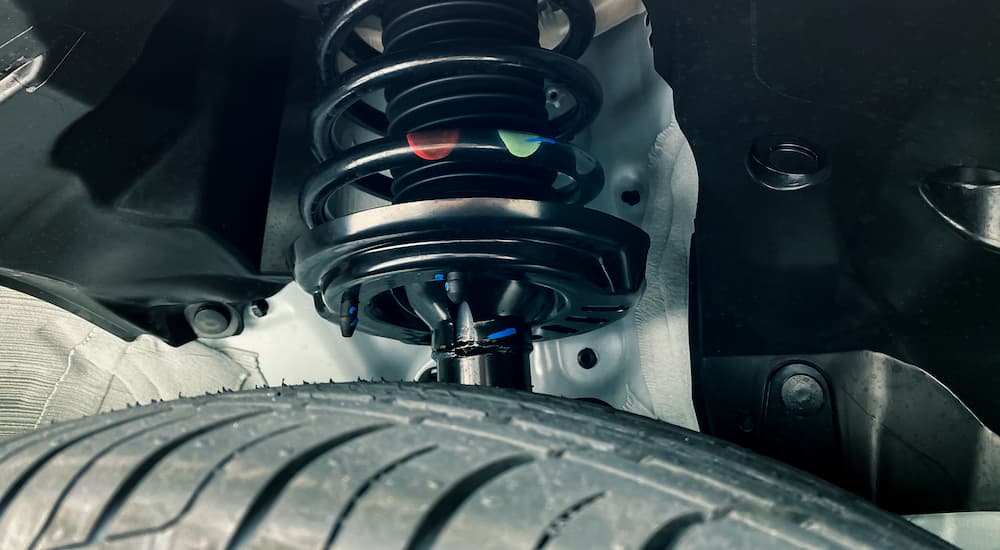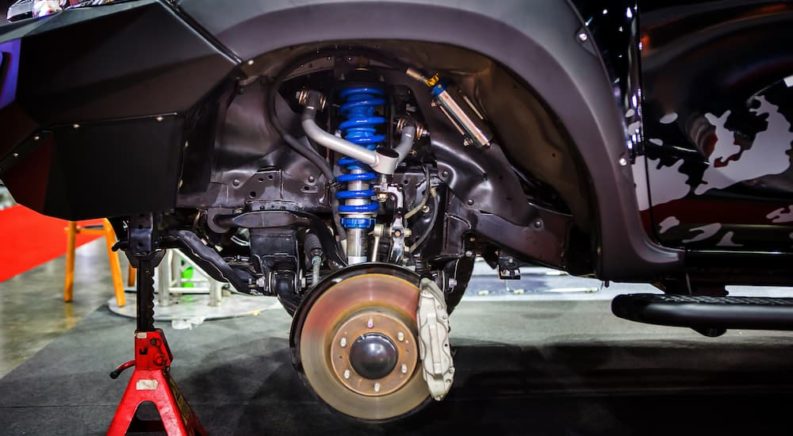The suspension in every car, truck, or SUV has two main components: the springs and the shocks or struts. Somewhat counterintuitively, the springs are what support the weight of your car, while the shocks or struts (collectively known as dampers) are there to smooth things out and keep the springs from making the ride too bouncy. Most cars on the road today use both shocks and struts, and there is a difference between the two. Dampers also wear out over time, and it is important to check them at least once a year as old dampers will make your vehicle less comfortable and less safe.
Effects of Damping
If you have ever driven a vehicle with blown shocks, then you will immediately understand why cars have dampers. Without dampers in the suspension, the springs that support the vehicle will cause it to bounce up and down repeatedly with every bump. Acceleration, braking, and cornering will cause the car to lean backward, forwards, or sideways, and hard bumps will cause the suspension to bottom out with a jarring impact. Not only is all of this extremely uncomfortable and disconcerting, but it has a real impact on performance and handling.
The suspension of your vehicle is designed to keep all four tires solidly in contact with the road at all times. Without proper damping, the tires can’t maintain good traction, resulting in unresponsive handling and longer braking distances. Performance cars go to great lengths to tune the damping perfectly, even incorporating adaptive dampers that can adjust to changing road surfaces. Going to these lengths isn’t necessary in the average car or truck, but in worst-case scenarios, failing shocks or struts pose a real safety hazard and can even cause accidents.
Shocks vs Struts – What’s the Difference?
While you may have heard the terms shocks and struts thrown around interchangeably before, they are not the same thing. Both shocks and struts are a form of damper that uses hydraulics to control the compression and rebound of a vehicle’s springs; however, the two take slightly different forms, and each has its pros and cons. Most modern cars and SUVs use struts for the front suspension and shocks for the rear suspension. However, trucks and older vehicles are usually fitted with shocks front and rear, while many sports cars use struts on both ends.
The difference between a shock and a strut comes down to the placement of the springs in the suspension. A shock is installed separately from the spring, while a strut has the spring wrapped around it. Struts make for a very compact system and are often used in the front suspension to free up room in the engine bay; however, they are generally a bit more expensive and more difficult to replace. Shocks are simpler and cheaper, but take up more space, so are usually used in larger vehicles. Shocks also have the advantage of working with leaf springs, while struts can only be used with coil springs.
Do You Need New Dampers?
Shocks and struts wear out over time, slowly becoming less effective. Because they last for tens of thousands of miles and tend to fail gradually, catching failing shocks can be difficult––you simply don’t notice the slow loss of performance. Damper life can also vary dramatically depending on the road conditions and your driving style, so there isn’t a set mileage that you should always replace your dampers at. However, that doesn’t mean there aren’t any signs that your shocks or struts are on their way out, and it’s time to start thinking about replacing them. In fact, you can easily test your car to see if the dampers are bad without any tools or mechanical knowledge at all!
The official test for bad dampers is to simply push down hard on the front or rear of your car and let go. If the dampers are good, the car will pop back up to its correct ride height and stop. However, if the car bounces more than once, it’s a sign that the dampers are not properly controlling the springs and need to be replaced. Still, this simple test will only catch dampers that are truly in bad shape and need to be replaced at once. Ideally, you want to replace shocks and struts long before they reach this point. Other signs of failing dampers to watch for include unusual tire wear, any sort of bouncy ride, or the car starting to lean when turning, braking, or accelerating. These signs can be subtle, so paying close attention to your car is usually necessary to see them.
Upgrading Shocks and Struts
When it comes time to replace the dampers in your vehicle, you have options. For the average driver, sticking to factory replacement parts or good quality aftermarket parts will bring your car back up to spec at a reasonable price. However, you can also tweak the handling of your car by exploring other aftermarket options. There are many performance-oriented aftermarket shocks and struts that are designed to sharpen the handling of your car by increasing the damping rates––just take note that higher damping means less shock absorption. Many track-oriented parts or cheaper brands will increase the damping rates so high that it will make the car uncomfortable to drive. Still, there are plenty of street performance options from quality brands that blend performance with comfort.
There are also more durable dampers available, which can be appealing if you have a truck or SUV that you take on the trail regularly. Road-oriented shocks often don’t last long when put through the wringer off-road, so upgraded shocks can be a great investment for the adventurer. Off-road-oriented shocks will usually use more durable materials and incorporate design features intended to prevent the hydraulics inside from failing under intense use. They might also incorporate lower damping rates designed to make traveling along bumpy trails a bit more comfortable and less damaging to the suspension.

Advanced Damper Types – Coilovers and Reservoir Shocks
When it comes to high-performance cars and trucks, you will often see two more types of dampers used. These are most often added as aftermarket upgrades, but sometimes they come stock from the factory. When it comes to cars, coilovers are preferred by many enthusiasts because they are simple to install and add adjustability to the suspension. In form, a coilover and a strut appear almost identical, as both consist of a coil spring wrapped around a damper. The difference is that a coilover can be adjusted to change the spring compression and alter the vehicle’s ride height. Some coilovers (and some more expensive shocks and struts) also allow you to adjust the damping rates as well as fine-tune the suspension.
When it comes to off-roading, reservoir shocks are the way to go. These look like normal shocks, except they have a hose attached to an external reservoir containing additional hydraulic fluid. This allows for more suspension travel on rough terrain and lower operating pressures for longer life. The additional hydraulic fluid also helps prevent overheating under prolonged harsh use. There are actually two slightly different types of reservoir shocks. Piggyback reservoirs have the external reservoir attached directly to the shock, while remote reservoirs have the reservoir attached to the body of the truck. Both have their supporters, but it mostly comes down to which fits your vehicle better.
Don’t Neglect Your Shocks and Struts
Suspension is often an invisible component of any car, truck, or SUV. It’s all hidden under your car, and most of the components will last for the life of your vehicle without replacement. However, the suspension is a critical component that ensures your comfort and safety on the road. Neglecting your shocks and struts will have a measurable impact on your vehicle’s performance, so it’s in your best interest to keep an eye on them and make sure they are still functioning properly. Don’t wait for them to fail completely, and plan on replacing them when you first start noticing reduced performance so that your car continues to drive just like it did when new.

